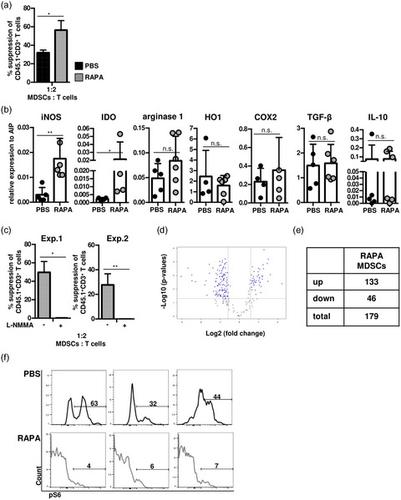当前位置:
X-MOL 学术
›
Clin. Exp. Immunol.
›
论文详情
Our official English website, www.x-mol.net, welcomes your feedback! (Note: you will need to create a separate account there.)
Rapamycin-based graft-versus-host disease prophylaxis increases the immunosuppressivity of myeloid-derived suppressor cells without affecting T cells and anti-tumor cytotoxicity.
Clinical & Experimental Immunology ( IF 4.6 ) Pub Date : 2020-07-18 , DOI: 10.1111/cei.13496 J Scheurer 1 , T Reisser 1 , F Leithäuser 2 , J J Messmann 1 , K Holzmann 3 , K-M Debatin 1 , G Strauss 1
Clinical & Experimental Immunology ( IF 4.6 ) Pub Date : 2020-07-18 , DOI: 10.1111/cei.13496 J Scheurer 1 , T Reisser 1 , F Leithäuser 2 , J J Messmann 1 , K Holzmann 3 , K-M Debatin 1 , G Strauss 1
Affiliation

|
The immunosuppressant rapamycin (RAPA) inhibits mammalian target of rapamycin (mTOR) functions and is applied after allogeneic bone marrow transplantation (BMT) to attenuate the development of graft‐versus‐host disease (GVHD), although the cellular targets of RAPA treatment are not well defined. Allogeneic T cells are the main drivers of GVHD, while immunoregulatory myeloid‐derived suppressor cells (MDSCs) were recently identified as potent disease inhibitors. In this study, we analyzed whether RAPA prevents the deleterious effects of allogeneic T cells or supports the immunosuppressive functions of MDSCs in a BMT model with major histocompatibility complex (MHC) classes I and II disparities. RAPA treatment efficiently attenuated clinical and histological GVHD and strongly decreased disease‐induced mortality. Although splenocyte numbers increased during RAPA treatment, the ratio of effector T cells to MDSCs was unaltered. However, RAPA treatment induced massive changes in the genomic landscape of MDSCs preferentially up‐regulating genes responsible for uptake or signal transduction of lipopeptides and lipoproteins. Most importantly, MDSCs from RAPA‐treated mice exhibited increased immunosuppressive potential, which was primarily inducible nitric oxide synthase (iNOS)‐dependent. Surprisingly, RAPA treatment had no impact on the genomic landscape of T cells, which was reflected by unchanged expression of activation and exhaustion markers and cytokine profiles in T cells from RAPA‐treated and untreated mice. Similarly, T cell cytotoxicity and the graft‐versus‐tumor effect were maintained as co‐transplanted tumor cells were efficiently eradicated, indicating that the immunosuppressant RAPA might be an attractive approach to strengthen the immunosuppressive function of MDSCs without affecting T cell immunity.
中文翻译:

基于雷帕霉素的移植物抗宿主病预防措施可增加髓样抑制细胞的免疫抑制性,而不会影响T细胞和抗肿瘤细胞毒性。
免疫抑制剂雷帕霉素(RAPA)抑制哺乳动物雷帕霉素靶蛋白(mTOR)的功能和同种异体骨髓移植(BMT)之后被施加到衰减的移植物的发展与宿主疾病(GVHD),尽管RAPA治疗的细胞靶标尚未明确。异体T细胞是GVHD的主要驱动力,而免疫调节性髓样抑制细胞(MDSC)最近被确定为有效的疾病抑制剂。在这项研究中,我们分析了RAPA是否能阻止异基因T细胞的有害作用或支持具有主要组织相容性复合体(MHC)I级和II级差异的BMT模型中MDSC的免疫抑制功能。RAPA治疗有效降低了临床和组织学GVHD,并大大降低了疾病引起的死亡率。尽管在RAPA治疗期间脾细胞数量增加,但效应T细胞与MDSC的比例未改变。然而,RAPA处理导致MDSCs基因组格局发生巨大变化,优先上调负责脂肽和脂蛋白摄取或信号转导的基因。最重要的是,来自RAPA处理的小鼠的MDSC表现出更高的免疫抑制潜能,这主要是诱导型一氧化氮合酶(iNOS)依赖性的。出人意料的是,RAPA处理对T细胞的基因组格局没有影响,这可以通过RAPA治疗和未治疗小鼠的T细胞中活化和衰竭标记以及细胞因子谱的不变表达来反映。同样,T细胞的细胞毒性和移植物 这主要是诱导型一氧化氮合酶(iNOS)依赖性的。出人意料的是,RAPA处理对T细胞的基因组格局没有影响,这可以通过RAPA治疗和未治疗小鼠的T细胞中活化和衰竭标记以及细胞因子谱的不变表达来反映。同样,T细胞的细胞毒性和移植物 这主要是诱导型一氧化氮合酶(iNOS)依赖性的。出人意料的是,RAPA处理对T细胞的基因组格局没有影响,这可以通过RAPA治疗和未治疗小鼠的T细胞中活化和衰竭标记以及细胞因子谱的不变表达来反映。同样,T细胞的细胞毒性和移植物由于有效地根除了共移植的肿瘤细胞,肿瘤相对于肿瘤的作用得以维持,这表明免疫抑制剂RAPA可能是增强MDSCs免疫抑制功能而不影响T细胞免疫力的一种有吸引力的方法。
更新日期:2020-07-18
中文翻译:

基于雷帕霉素的移植物抗宿主病预防措施可增加髓样抑制细胞的免疫抑制性,而不会影响T细胞和抗肿瘤细胞毒性。
免疫抑制剂雷帕霉素(RAPA)抑制哺乳动物雷帕霉素靶蛋白(mTOR)的功能和同种异体骨髓移植(BMT)之后被施加到衰减的移植物的发展与宿主疾病(GVHD),尽管RAPA治疗的细胞靶标尚未明确。异体T细胞是GVHD的主要驱动力,而免疫调节性髓样抑制细胞(MDSC)最近被确定为有效的疾病抑制剂。在这项研究中,我们分析了RAPA是否能阻止异基因T细胞的有害作用或支持具有主要组织相容性复合体(MHC)I级和II级差异的BMT模型中MDSC的免疫抑制功能。RAPA治疗有效降低了临床和组织学GVHD,并大大降低了疾病引起的死亡率。尽管在RAPA治疗期间脾细胞数量增加,但效应T细胞与MDSC的比例未改变。然而,RAPA处理导致MDSCs基因组格局发生巨大变化,优先上调负责脂肽和脂蛋白摄取或信号转导的基因。最重要的是,来自RAPA处理的小鼠的MDSC表现出更高的免疫抑制潜能,这主要是诱导型一氧化氮合酶(iNOS)依赖性的。出人意料的是,RAPA处理对T细胞的基因组格局没有影响,这可以通过RAPA治疗和未治疗小鼠的T细胞中活化和衰竭标记以及细胞因子谱的不变表达来反映。同样,T细胞的细胞毒性和移植物 这主要是诱导型一氧化氮合酶(iNOS)依赖性的。出人意料的是,RAPA处理对T细胞的基因组格局没有影响,这可以通过RAPA治疗和未治疗小鼠的T细胞中活化和衰竭标记以及细胞因子谱的不变表达来反映。同样,T细胞的细胞毒性和移植物 这主要是诱导型一氧化氮合酶(iNOS)依赖性的。出人意料的是,RAPA处理对T细胞的基因组格局没有影响,这可以通过RAPA治疗和未治疗小鼠的T细胞中活化和衰竭标记以及细胞因子谱的不变表达来反映。同样,T细胞的细胞毒性和移植物由于有效地根除了共移植的肿瘤细胞,肿瘤相对于肿瘤的作用得以维持,这表明免疫抑制剂RAPA可能是增强MDSCs免疫抑制功能而不影响T细胞免疫力的一种有吸引力的方法。



























 京公网安备 11010802027423号
京公网安备 11010802027423号